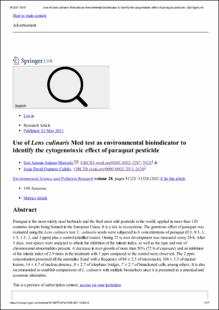Use of Lens culinaris Med test as environmental bioindicator to identify the cytogenotoxic effect of paraquat pesticide
Artículo de revista
2021-05-12
Environmental Science And Pollution Research
Berlin , Alemania
Paraquat is the most widely used herbicide and the third most sold pesticide in the world, applied in more than 120 countries despite being banned in the European Union. It is a risk to ecosystems. The genotoxic effect of paraquat was evaluated using the Lens culinaris test. L. culinaris seeds were subjected to 6 concentrations of paraquat (0.1, 0.5, 1, 1.5, 1.5, 2, and 3 ppm) plus a control (distilled water). During 72 h, root development was measured every 24 h. After 3 days, root apices were analyzed to obtain the inhibition of the mitotic index, as well as the type and rate of chromosomal abnormalities present. A decrease in root growth of more than 50% (72 h of exposure) and an inhibition of the mitotic index of 2.9 times in the treatment with 3 ppm compared to the control were observed. The 2 ppm concentration presented all the anomalies found with a frequency of 84 ± 2.5 of micronuclei, 106 ± 3.5 of nuclear lesions, 14 ± 4.7 of nucleus absence, 8 ± 2.7 of telophase bridges, 7 ± 2.7 of binucleated cells, among others. It is also recommended to establish comparisons of L. culinaris with multiple biomarkers since it is presented as a practical and economic alternative.
Descripción:
Use of Lens culinaris Med test as environmental bioindicator to identify the cytogenotoxic effect of paraquat pesticide.pdf
Título: Use of Lens culinaris Med test as environmental bioindicator to identify the cytogenotoxic effect of paraquat pesticide.pdf
Tamaño: 984.8Kb
 PDF
PDF
 LEER EN FLIP
LEER EN FLIP
Título: Use of Lens culinaris Med test as environmental bioindicator to identify the cytogenotoxic effect of paraquat pesticide.pdf
Tamaño: 984.8Kb
 PDF
PDF
 LEER EN FLIP
LEER EN FLIP
















